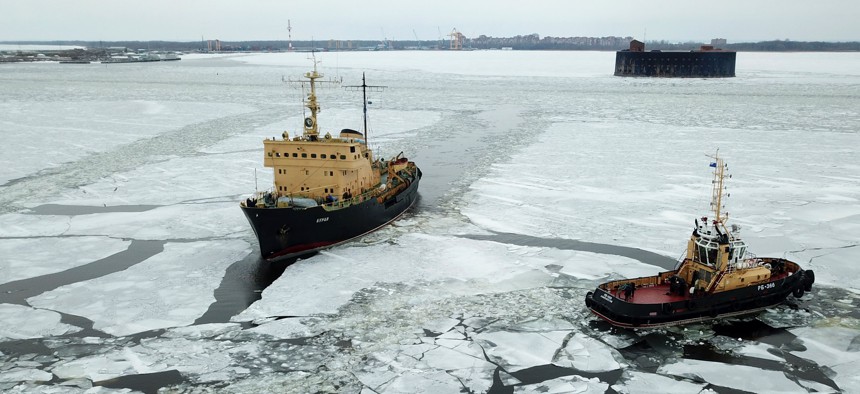
Russia's RB-366 tugboat and the Buran diesel-electric icebreaker break ice in the Gulf of Finland. Peter Kovalev\TASS via Getty Images
The Arctic Is No Substitute for Suez. We Should Keep It That Way.
One obvious way to reduce tensions in the region is to slow climate change and the use of northern sea routes.
The recent blockage of the Suez Canal spurred yet more commentary on the viability of the Northern Sea Route as an alternative to the chokepoint-laden lines of global commerce. But there remains good to reason to believe that a diversion of traffic north isn’t happening now and won’t happen anytime soon. Perhaps, as a matter of U.S. policy, it shouldn’t happen at all.
The strategic arguments for increased U.S. investment and presence in the Arctic are usually based on two overlapping phenomena: increased maritime accessibility and the potential for more commercial exploitation. The recent Navy and Marine Corps strategy notes that “melting sea ice is making Arctic waters more accessible and navigable, enabling greater trade in the coming decades.” The Army strategy warns of “possible future highways of maritime commerce,” with shorter Europe-to-Asia routes “avoiding maritime chokepoints.” The DOD strategy points to benefits for China, whose Arctic interests “are primarily focused on access to natural resources and the opportunities offered by the Arctic sea routes for Chinese shipping.” The common logic is that climate change will lead to more Arctic shipping and commerce, which will boost the region’s strategic significance, which will require more defense resources.
But the first links in this logical chain deserve more than a nod. The most comprehensive way to contain Arctic security issues, and reduce the demand for defense resources, is to address climate change and its immediate consequences for Arctic shipping.
If it is prudent for the Defense Department to hedge against failures to mitigate climate change, it becomes even more important to encourage sustainable development to avoid destabilizing results. One such result, as claimed by the strategies, is shifts in sea lines of communication, which incidentally feed back into the primary concern over climate change. Sea ice and glacial melt resulting from black carbon ship emissions (trending up even as other sources decline), and the prospect of maritime disasters as a result of the NSR’s limited charting, would hasten warming and the degradation of a delicate ecosystem. That is bad, generally, but particularly so if the Defense Department views a fast-warming Arctic as strategically destabilizing, warranting the infusion of resources to manage changing power dynamics.
Pushing to eliminate economic investment in the Arctic is untenable for the region’s communities. Yet the United States can advocate against activities that are most disruptive to the environment or that otherwise risk shifting critical distributions of power. On both accounts, the U.S. should support initiatives to moderate the level of Arctic through-traffic as a central feature of its regional security policy. Amplifying those efforts would have the virtue of being both the morally and strategically sensible course of action. Moreover, a reduction in transits would not mean zero transits, and so the U.S. position on the Northern Sea Route, or NSR, as an international strait should remain unchallenged.
If it initially seems like a fool’s errand to stand astride Arctic shipping yelling “stop,” recent developments suggest the idea is viable. In response to the latest advertising campaign for the NSR, the shipping line MSC reiterated its commitment not to use Arctic routes on environmental grounds. The pledge, first made in 2019, is one among several carrier giants (including Evergreen, Ever Given’s operator) and multiple international brands (such as Ralph Lauren, Puma, Gap, and H&M) that have joined the Ocean Conservancy / Nike Arctic Shipping Corporate Pledge. This pledge is good for the environment—but it would also make for sound U.S. security policy as the Defense Department struggles to meet global demands for forces.
And what of the practicality of this approach? It is easy to be skeptical of corporate social responsibility claims like that of MSC’s, especially those that defer difficult choices. Yet companies often see competitive advantages in taking potential (or even real) losses to position themselves more effectively. CVS accepted about $2 billion in revenue loss when it stopped selling tobacco products in 2014. The short-term hit was judged a sensible gamble in order to clarify the brand’s image, in particular as smoking became less common anyway.
In the U.S., and in much of Europe, younger people (high-value consumers and high-skilled talent for whom consumer brands compete) are increasingly energized about climate change, and they often see climate action as an opportunity, not a cost. Consequently, pledges like those from MSC and the brands they carry may prove durable, even as Arctic routes become more economical. And if the attestation in U.S. Arctic strategies is true—that increased shipping traffic is cause for a shift in U.S. defense investments in the Arctic—then a growing climate enthusiasm could be a strategic asset for the United States. The stated disinterest among shippers against using Arctic routes is not well integrated into the Defense Department's strategies on managing a changing region. Yet if the U.S. wants to mitigate warming, avoid a regional power disruption in the Arctic, and safeguard the dedication of resources to other theaters, it should be.
Dr. Joshua Tallis is a maritime and polar analyst at the Center for Naval Analyses, and is the author of The War for Muddy Waters: Pirates, Terrorists, Traffickers, and Maritime Insecurity. The views in this article do not necessarily reflect those of his employer.



